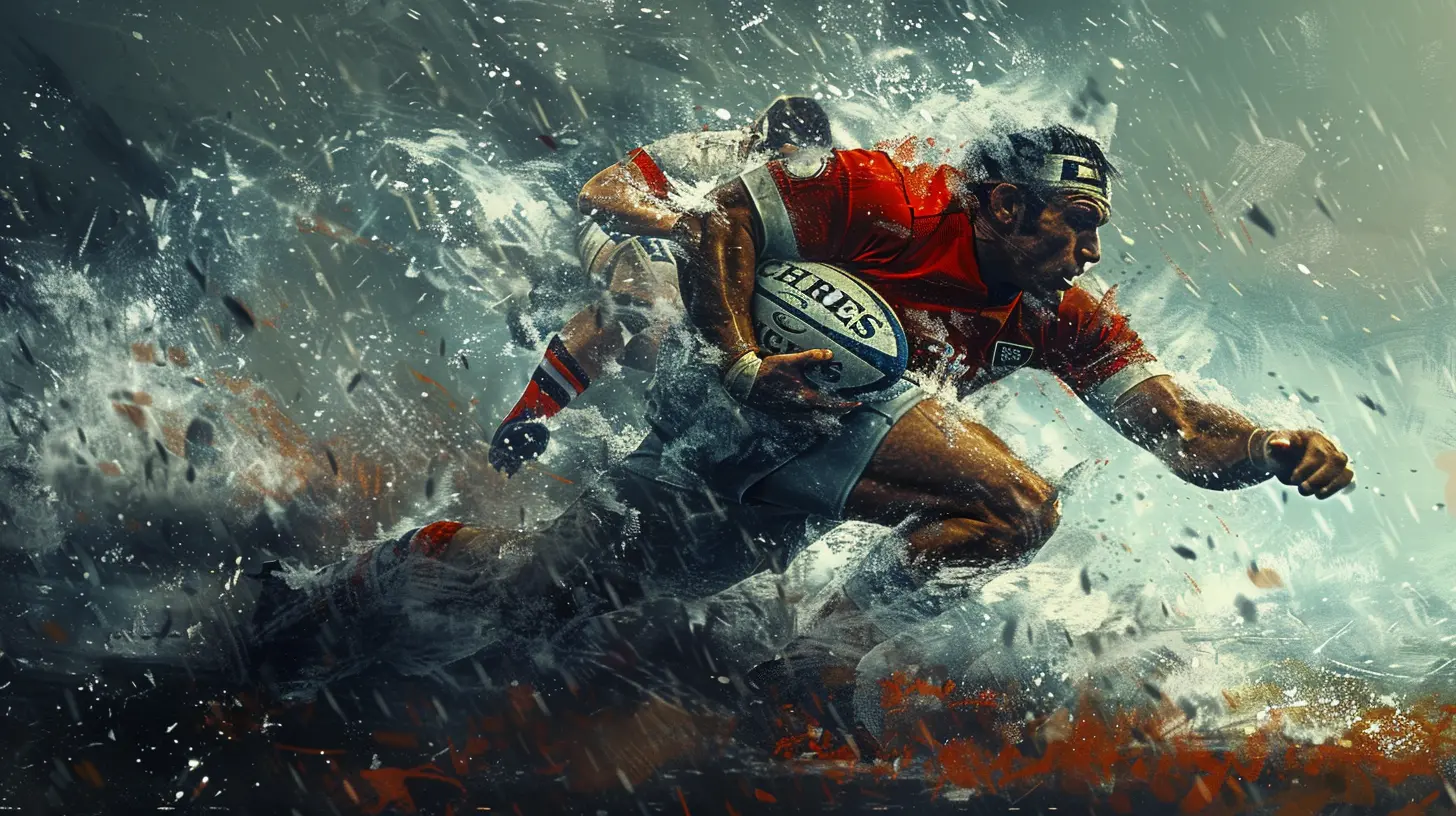The Art of the Offload: Creating Space and Breaking the Line
21 May 2025
If you're a rugby fan, you already know that an offload is one of the most exciting and skillful moves in the game. It's a moment of magic that can unlock a defense, turn half-chances into tries, and leave defenders grasping at thin air. But what makes a great offload? How do players master this art and use it to create space and break the defensive line?
Let’s dive deep into the world of offloads, breaking down the techniques, strategies, and game-changing impact this skill brings to the sport. 
What is an Offload in Rugby?
An offload is a pass made by a ball carrier while being tackled or just before they hit the ground. The aim? To keep the play alive, maintain attacking momentum, and avoid the slow process of a ruck.When executed correctly, an offload can turn a defensive situation into an attacking opportunity within seconds. It forces defenders to scramble, disrupts defensive lines, and can create gaps for supporting players to exploit.
But here’s the catch—the offload isn't a free-for-all trick that works every time. It requires precision, awareness, and the ability to read the game in real-time. 
Why Is the Offload So Effective?
The offload is such a deadly weapon because it does several things at once:- Maintains attacking flow – Instead of resetting with a ruck, play continues seamlessly.
- Disrupts defensive structures – Defenders expect a tackled player to go to ground; an offload messes up their positioning.
- Creates space for teammates – Defenders committing to the tackle leave openings elsewhere.
- Generates quick attacking momentum – A well-timed offload can put a teammate into open space at full speed.
In short, an offload is rugby’s version of a fast break in basketball—quick, aggressive, and often devastating. 
The Key Ingredients of a Great Offload
Not every player can pull off a killer offload. It takes skill, awareness, and the right mindset. Here are the crucial factors that separate an average offload from a game-breaking one.1. Timing is Everything
Release the ball too early, and defenders will react. Too late, and it becomes a risky turnover. The sweet spot is just before the point of full commitment in a tackle—this keeps defenders engaged while giving the recipient time to react.2. Strong Ball Control
Great offloaders have exceptional grip strength and control. This allows them to manipulate the ball in tight situations, using one-handed or two-handed passes depending on the angle and pressure.3. Vision and Awareness
You can’t just fling the ball blindly and hope for the best. The best offloaders have incredible awareness, scanning for support before even making contact with the defender. Players like Sonny Bill Williams, known for his ridiculous offloads, always seem to know exactly where their teammates are without looking.4. Body Positioning and Balance
Keeping a strong core and balanced stance helps maintain control even under pressure. Good offloaders stay composed in contact, using their legs to generate extra time before delivering the pass.5. Communication
Offloads don’t work without support runners. A well-timed call, eye contact, or hand gesture can be the difference between a successful offload and a lost possession.
Types of Offloads and When to Use Them
There isn’t just one way to offload—different situations call for different types of passes. Here are some of the most effective ones:1. The Classic One-Handed Offload
Often seen in high-contact situations, this involves holding the ball in one hand and flipping it to a teammate while being tackled. It's risky but allows for quicker execution when movement is restricted.2. The Two-Handed Pop Pass
A safer option, this version keeps both hands on the ball until the last second, making it easier to adjust direction and pace. This is useful when a teammate is running a short support line.3. The Backhand Flick
A flashy but effective offload where the ball carrier flicks the ball behind their back to a teammate. It requires flair and confidence but can be deadly when used correctly.4. The Offload to Ground
Instead of passing in the air, the ball is released to bounce once before reaching the support runner. This method can help maintain possession when an opponent is aggressively contesting the ball.How to Train for Better Offloads
Like any skill, mastering the offload requires practice. Here are some drills to help improve your offloading game:1. Contact and Release Drills
Practicing offloads while being tackled helps develop composure under pressure. Training with small-sided games where offloading is encouraged can help players get comfortable with timing.2. Reaction Drills
Having players call for the ball after contact forces the ball carrier to react quickly, improving vision and awareness in tight situations.3. Grip and Hand Strength Workouts
Holding and manipulating the ball with one hand requires strong fingers and wrists. Grip strength exercises, such as squeezing a rugby ball or using hand grippers, can improve control.4. Communication-Based Drills
Encouraging players to use vocal and visual cues helps create chemistry among teammates, making offloads more effective in real games.When NOT to Offload
While the offload is a game-changer, knowing when not to use it is just as crucial. An ill-advised offload can lead to turnovers, counterattacks, and unnecessary risks.Here are some times when keeping the ball is the better option:
- No support players nearby – If there's no clear recipient, it's better to go to ground and set up a ruck.
- Heavy defensive pressure – Sometimes absorbing the tackle and recycling possession is the smarter play.
- Risk of interception – If defenders are lurking, an offload can do more harm than good.
Smart offloaders don’t force the pass—they wait for the right moment.
Legendary Offloaders in Rugby History
Some players have turned offloading into an art form. Let’s take a quick look at a few legends known for their insane offloading ability:- Sonny Bill Williams (New Zealand) – A master of one-handed offloads, his ability to keep the ball alive was second to none.
- Jason Robinson (England) – While known for his footwork, Robinson’s offloading kept defenders guessing.
- Fiji's Rugby Sevens Team – Sevens rugby thrives on quick ball movement, and the Fijians have perfected the art of offloading under pressure.
Watching these players in action is like watching poetry in motion—effortless, unpredictable, and devastatingly effective.
Final Thoughts
The offload is more than just a flashy skill—it’s a strategic weapon that can unlock defenses and create game-changing moments. But it’s not about throwing the ball wildly. The best players know when to offload, how to offload, and why they’re doing it.So, the next time you watch a game, keep an eye out for those moments of brilliance. And if you're a player, work on your timing, vision, and control—because a well-executed offload might just be the difference between winning and losing.
all images in this post were generated using AI tools
Category:
RugbyAuthor:

Uziel Franco
Discussion
rate this article
3 comments
Lana Black
The offload is a crucial skill in modern rugby, transforming defensive pressure into attacking opportunities. By executing timely offloads, players can create space, disrupt defensive lines, and maintain momentum, ultimately leading to scoring chances. Mastery of this technique enhances overall team dynamics and effectiveness.
May 28, 2025 at 5:01 AM

Uziel Franco
Absolutely! Mastering the offload not only enhances individual skills but also significantly boosts team performance by exploiting defensive gaps and generating scoring opportunities.
Nell Newton
Offloads are game-changers; master them to win!
May 27, 2025 at 4:32 AM

Uziel Franco
Absolutely! Mastering offloads can elevate your game and open up new possibilities on the field.
Celeste Sheppard
This article brilliantly highlights the strategic importance of the offload in modern rugby. By creating space and breaking defensive lines, players can transform gameplay dynamics. The detailed analysis and examples effectively illustrate how mastering this skill can elevate a team's performance. A must-read for aspiring players and coaches alike!
May 21, 2025 at 2:48 AM

Uziel Franco
Thank you for your thoughtful feedback! I'm glad you found the article insightful and valuable for players and coaches. Your support is greatly appreciated!
![Breaking Records and Barriers: [Player Name]s Historic Season](/pictures/blog/small/breaking-records-and-barriers-player-names-historic-season_3.webp)


